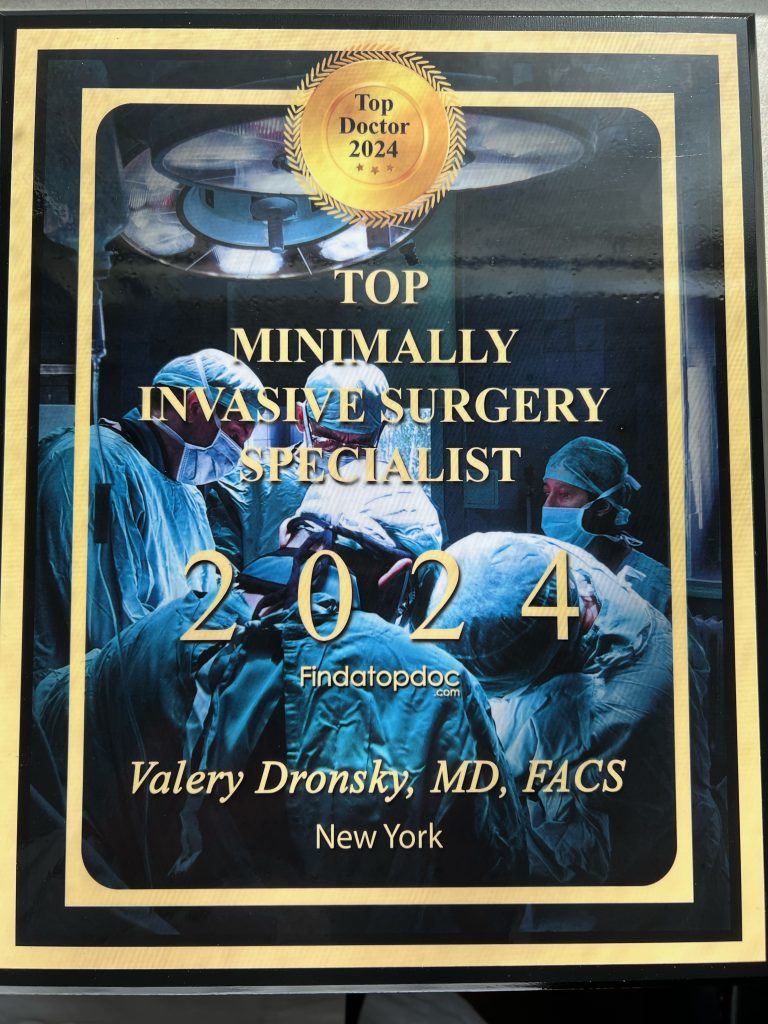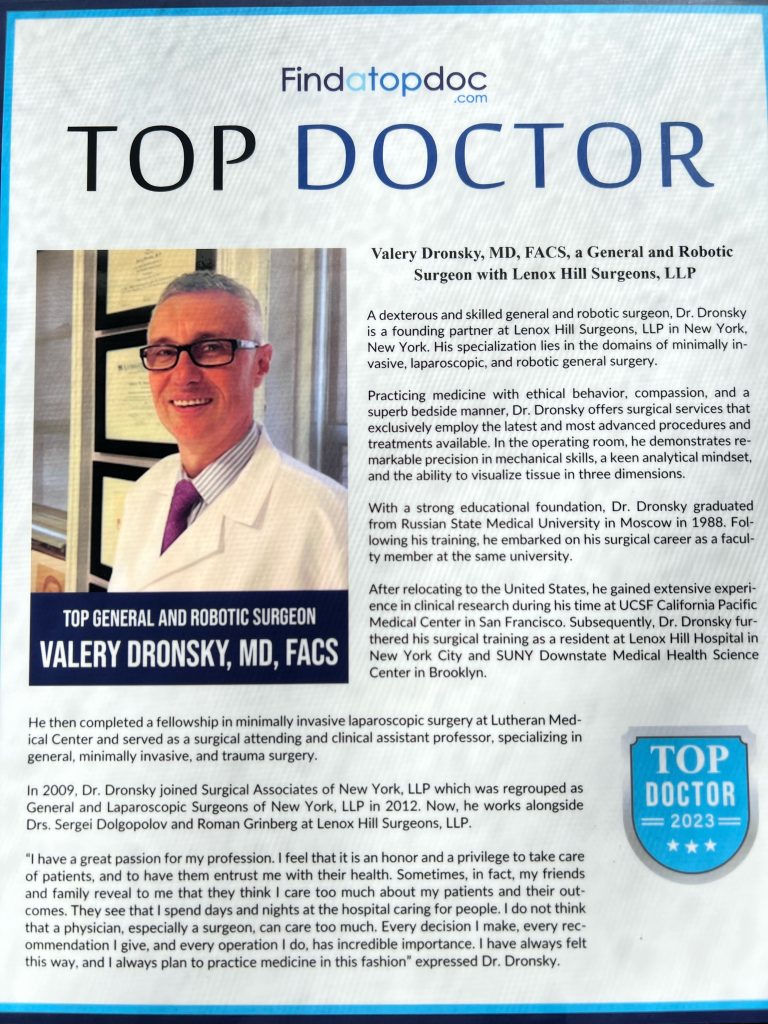CALL TODAY 646-846-1136 | EMAIL
Surgical Experts Dedicated to Improving Lives
At Lenox Hill Minimally Invasive Surgery PLLC, Dr. Valery Dronsky and his staff of medical professionals provide compassionate care with the highest ethical & professional standards. In our state of the art facility, we offer surgical services using only the most cutting edge and current procedures and treatments. We specialize in general surgery, including extensive experience in performing hernia repair surgery. Our expertise is in minimally invasive surgery and robotic surgery. Minimally invasive and robotic surgery often allow patients to experience easier recovery than traditional open surgery. They also allow for more precise and less traumatic surgery. When robotic and minimally invasive surgery is not an option, we are also skilled and experienced in traditional open surgical procedures.
Dr. Dronsky is an experienced and highly skilled surgeon having undergone extensive training in school, residency and fellowships. He practices medicine with ethical behavior, compassion and superb bedside manner. In the operating room he exhibits precision mechanical abilities, analytical thinking and the ability to visualize tissue in three dimensions. These innate and learned skills allow Dr. Dronsky to be one of the most dexterous and skilled professionals in New York City and the Country.
Call us: 646-846-1136
PATIENT TESTIMONIALS
Recent Awards
We are honored and deeply appreciative to have consistently received prestigious awards and recognition year after year, establishing us as one of New York’s foremost hospitals for a wide range of general surgeries, safety measures, specialized procedures, and overall excellence in healthcare. At Lenox Hill Minimally Invasive Surgery, our unwavering commitment lies in delivering exceptional care and unwavering support to our patients, guaranteeing their safety and successful recovery throughout their entire surgical experience.
Hospital Quality Awards
 America’s 50 Best Hospitals Award™ (2023, 2022)
America’s 50 Best Hospitals Award™ (2023, 2022)
Top 1% in the nation for providing the highest clinical quality year over year.

America’s 100 Best Hospitals Award™ (2021)
Top 2% in the nation for consistently delivering clinical quality year over year.

America’s 250 Best Hospitals Award™ (2023, 2022, 2021)
Top 5% in the nation for consistently delivering clinical quality.

Patient Safety Excellence Award™ (2023, 2022)
Top in the nation for providing excellence in patient safety by preventing infections, medical errors, and other preventable complications.
Specialty Clinical Quality Awards

America’s 100 Best Hospitals for Cardiac Care Award™ (2023, 2022, 2021, 2020, 2019)
Superior clinical outcomes in heart bypass surgery, coronary interventional procedures, heart attack treatment, heart failure treatment, and heart valve surgery.

America’s 100 Best Hospitals for Coronary Intervention Award™ (2023, 2022, 2021, 2020, 2019)
Superior clinical outcomes in coronary intervention procedures (angioplasty with stent).

America’s 100 Best Hospitals for Prostate Surgery Award™ (2023, 2022, 2021)
Superior clinical outcomes in prostate removal surgery and transurethral resection of the prostate.
Click to see all of our Healthgrades best doctors awards




Visit our main website at www.LenoxHillMinimallyInvasiveSurgery.com
Blog Posts are Below:
Tag Archives: appendix removal surgery
Appendix Removal Surgery
What is the process of appendix removal surgery? The appendix is a small tube-shaped organ inside the human body. It sits in the lower right side region of the abdomen. Medical experts do not exactly know about the function and purpose of the appendix organ. To this day, the exact functionality of the appendix is unknown. However, some believe that it aids in the digestion process. However, appendix removal, or appendectomy is a very common procedure and the removal of the appendix has no affects on the health of a person.
Appendectomy
An appendectomy is a surgical procedure that aims to remove the appendix from a person’s body. Usually, people who undergo this surgery are emergency patients that come are suffering from appendicitis.
Appendicitis
Appendicitis is a disease that causes the appendix to swell up. The swelling of the appendix is an inflammatory response of the appendix. Appendicitis occurs when there is a bacterial invasion inside the appendix. The bacteria inside the appendix begin to multiply and create puss. Consequently, when the puss increases, it starts to press against the inner walls of the appendix, since it cannot escape. As a result, the appendix starts to become swollen, and the pressure inside increases, causing severe pain to an individual.
This pain starts in the lower right side of the stomach and spreads all across the abdominal area. A person suffering from appendicitis pain has trouble walking, coughing, or doing any other activity. Some of the intense symptoms of appendicitis include vomiting, stomach pain, nausea, fever, diarrhea, and fainting in some cases. Appendicitis is an emergency, and a person needs to get medical attention as soon as possible.
Delaying appendicitis can lead to an adverse situation for a person. Since the accumulation of the pus stretches and pressure the appendix. Delaying appendectomy can ultimately cause the appendix to burst once the pressure reaches its peak point. Having a perforated appendix inside the abdominal region can lead to complications. This is because the bacterial material burst out into the abdominal cavity. In this circumstance, one puts the other abdominal organs into harm.
How to Prepare for an Appendectomy?
Before a patient goes into surgery, they have to complete an eight hour fast, in which they do not eat or drink anything. The doctor will also make a complete list of the medications you take so that the doctor can tell you whether you need to continue them before and after surgery. Other information is also necessary such as previous medical conditions and allergies. This information is important since it helps the doctor determine the surgical technique they will use and the medications they will provide.
Diagnosis
Initially, when a patient suffering from appendicitis goes to the doctor, the doctor will likely perform a physical examination. This examination includes asking the patient about the location of the pain and gently pushing the abdominal region to spot the location and source of the pain. Once the doctor confirms the physical diagnosis of appendicitis, they may also run digital screening tests to re-confirm appendicitis. However, this may not be necessary the appendix is at a critical stage. In that instance, the patient goes straight into surgery without imaging or blood tests.
Types of Appendectomy Procedures
There are two types of appendectomy procedures, the surgeons decide which ones to perform after consideration of certain factors. These factors involve the severity of the situation, the age and medical history of the patient, and the underlying conditions of the patient, especially bleeding disorders. The two types of procedures are open appendectomy and laparoscopic appendectomy.
Open Appendectomy
An open appendectomy is a simple and straightforward surgical approach. It involves a surgeon making an incision on the stomach. They make the incision on the lower right side of the stomach, which is the location where the appendix is situated. This allows them a full view of the appendix.
After the incision, the surgeon operates the infected appendix, removing it and cleaning any bacterial mess if the appendix bursts. This surgical approach is ideal when the appendix bursts because the surgeons have room to clean the interior parts.
Laparoscopic Appendectomy
Unlike open appendectomy, this surgical approach allows surgeons to make smaller incisions on the abdomen. After the incisions, they insert a small tube inside the abdomen and pump carbon dioxide gas inside it so that the stomach is inflated and they have room to use the laparoscope.
This is a tube-like device, with a high-intensity light and camera attached on its end. Surgeons use this device to navigate the appendix and cut it off with the help of stitches. Furthermore, this surgery is more favorable to people that are old, overweight, or have bleeding issues. The smaller incisions allow them to recover faster.
Appendix Removal Surgery: Conclusion
If you or any of your close relatives have symptoms that point to appendicitis, make sure that you do not leave it unnoticed. Lenox Hill Minimally Invasive Surgery is a medical facility in New York that makes it easy for you to get treatment. Explore our website for more information or book an appointment now by calling 646-846-1136.

















